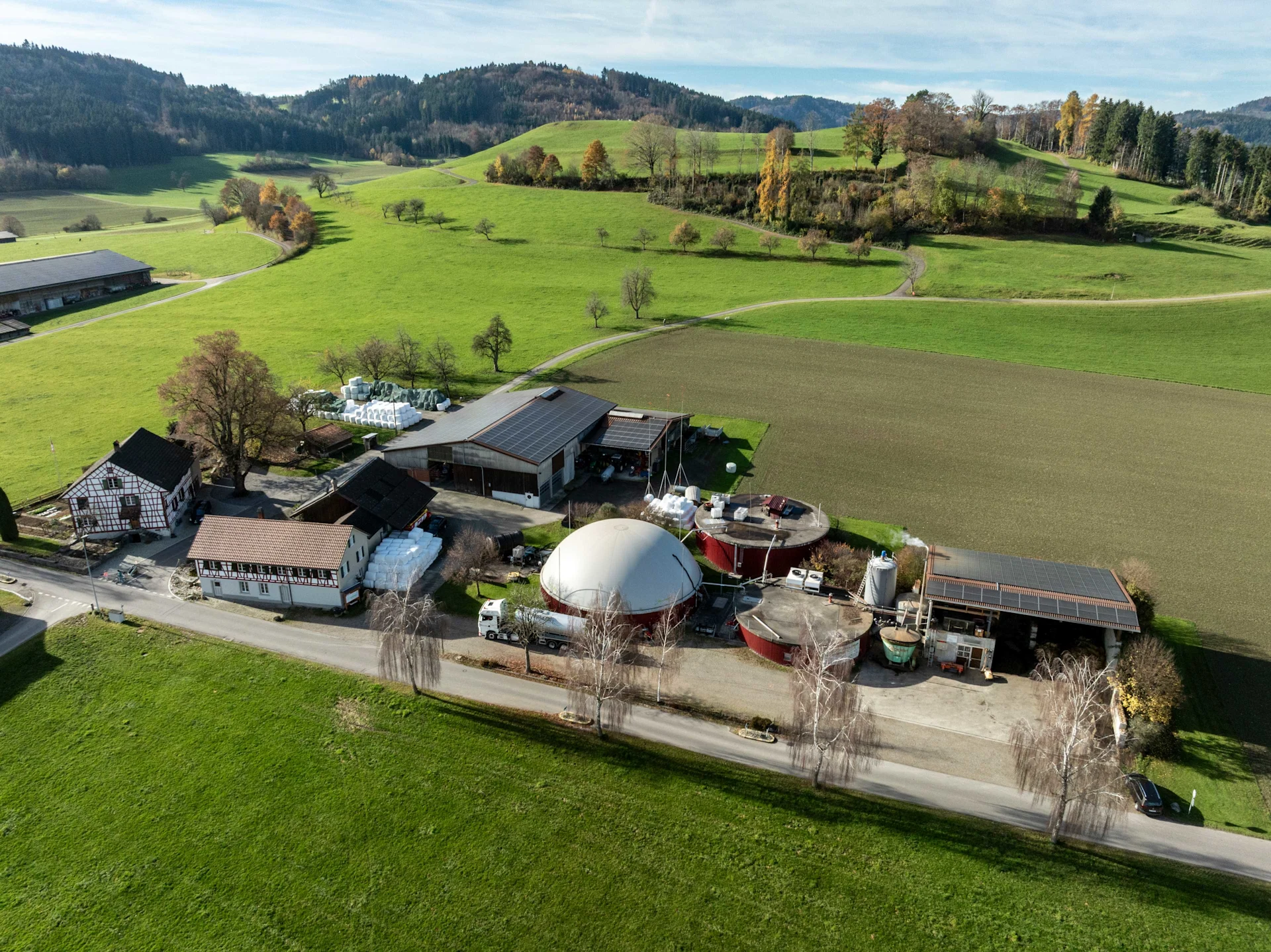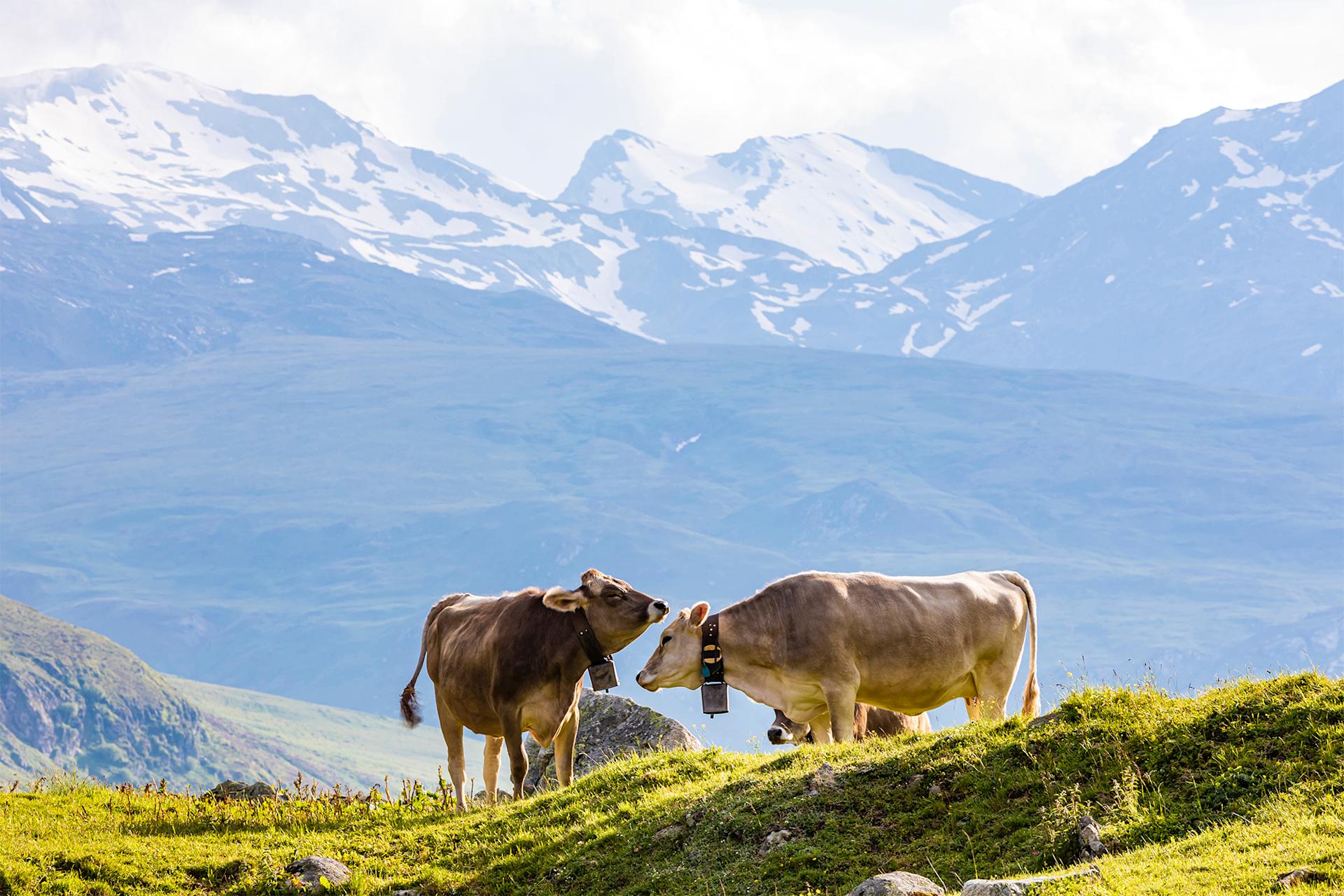
Sustainability
How is biogas produced?
Generated through the fermentation of liquid manure and other residual waste, can then be used for electricity.
navigation

Animal welfare
For many animals, the alpine summer has begun. But why do they go up to the heights at all? And why is it even good for the environment? We have the answers.
Dairy cows, mother cows and their calves, cattle, sheep, goats and horses graze on Swiss alpine pastures. Alpine pigs are even kept on some alps.
In total, more than half a million animals are being transported to the alpine pastures. About 400,000 of them are dairy cows, suckler cows and cattle.
Yes, for example, some of the Bio Weide-Beef cattle spend the summer months on the alp – depending on the farm tradition and location. While the organic pasture-raised beef animals in the valley graze for at least eight hours a day, those in the mountains are only out in the fresh air. On the alp, their feed also consists of 100 per cent pasture plants. “This is the most species-appropriate way to keep animals. This is also reflected in the high quality of the pasture-raised beef that Migros sells”, says Dennis Pisoni, sustainability expert at Micarna.
The alpine area where the animals spend their summer is called summering area. This area is not suitable for agricultural production due to the climatic situation. In Switzerland, these areas are located in the Alps, the Pre-Alps and the Jura. They cover a total of about 500,000 hectares. This corresponds to about one eighth of the total area of Switzerland.
It is a centuries-old tradition. The purpose of an alpine summer is to expand the food base for the farm animals. If the fodder in the valley is too scarce, farmers can take their herds to lush alpine pastures and thus ensure that they have enough to eat. Meanwhile, hay and green fodder can be conserved in the valley, thus providing for the cold months. The alpine parades are also of cultural and touristic importance. The beautifully decorated animals delight thousands of onlookers at the roadside.
No. More animals live in the valley than can go to alpine pastures. The alpine summer is time-consuming and not all farmers are committed to the traditions. That’s why the federal government provides financial support for summer grazing of livestock on alpine pastures, thus creating incentives for farmers. Also, because it is increasingly dry in the valleys during the summer months, the mountains are once again becoming an alternative.
This is not the same for all animals. Very high-yielding dairy cows cannot absorb enough nutrients on the alp to meet their requirements. Beat Reidy, professor of grassland use and ruminant systems at the Bern University of Applied Sciences, says: “If we’re talking about dairy cows with moderate performance, then the alp is a good thing.” These animals are adapted for the alp, he says, and the fresh air, exercise and fresh feed are good for them.
As a result, the pastures would gradually become overgrown. Everything below the timberline, which in Switzerland is around 1800 metres above sea level depending on the geographical location, would be strewn with bushes and in the longer term covered by forest. Cows can climb up to about 2000 metres above sea level, sheep even higher, as they manage with fewer nutrients. Without alpine animals, many ski slopes would sooner or later become overgrown, as they are often located in the summering area. The landscape would change considerably. According to the federal government’s area statistics, the forest area increased by about 2% between 2009 and 2018. According to expert Beat Reidy, most of this probably concerns alpine areas that were no longer used.
If the trend of deforestation were to continue, we would soon have many more wild animals such as bears or wolves in the Alpine region. Another scenario: In a few decades, the agricultural land in the valley will hardly be sufficient to supply all the people in this country with food. That’s why researcher Beat Reidy sees summering areas as a possible expansion of the food base of the future.
“No other area in Switzerland is as biodiverse as they are”, says Beat Reidy of the Bern University of Applied Sciences. This means that nowhere else can more plants and insects be found in one space. The farm animals help to maintain this system because they graze on the meadows, thus preserving them and at the same time fertilising them again with their dung.
According to the Federal Office for Agriculture, the number of summering farms has decreased from 7,472 to 6,663 between 2003 and 2021. However, as existing farms have merged or been taken over by neighbouring farms, the summering farms have tended to become larger. Overall, livestock numbers on the alps have been relatively stable over the past 20 years. While the number of dairy cows on alpine pastures has decreased by about ten percent since 2000, the number of suckler cows has tripled.
“You can indeed detect differences”, says expert Beat Reidy. This is probably due to the secondary ingredients, i.e. colouring, scenting or flavouring substances in the plants that grow on the alp.
Discover exciting stories about all aspects of Migros, our commitment and the people behind it. We also provide practical advice for everyday life.